When indoor spaces look too lifeless and cold, then it’s time to bring in plants! But which one should you choose?
If your room has low light and space is a premium, then our list of easy-to-grow, low-light hanging plants is perfect for you!
Marble Queen Pothos (Epipremnum aureum ‘Marble Queen’ )
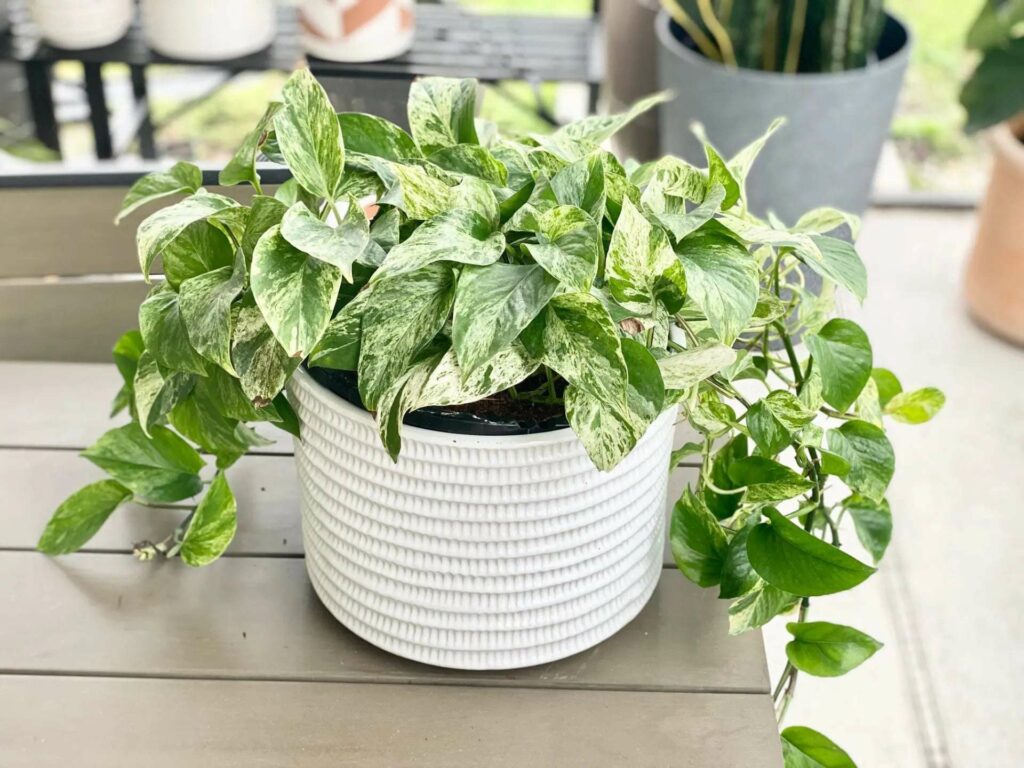
| Ease of Growing | Easy ●○○○○ |
| Blooming Season | Rarely blooms, typically grown for foliage |
| Size | Height: 6-10 feet, Width: 6-10 feet |
| Light | Indirect bright light, can tolerate low light conditions |
| Soil | Well-draining potting mix |
| Temperature | 65-80°F (18-27°C) |
| Watering | Allow soil to dry between watering, avoid overwatering |
| Toxicity | Toxic to pets if ingested |
| Benefits | Air-purifying, enhances indoor aesthetics |
It’s best to prune Marble Queen Pothos occasionally for shape and size control. Trimming overgrown vines encourages bushier growth.
Use balanced liquid fertilizer in the growing season, but beware of over-fertilizing to prevent soil salt buildup. Indoors, watch out for pests like spider mites and mealybugs – and treat them promptly.
Monstera adansonii (Monstera adansonii)
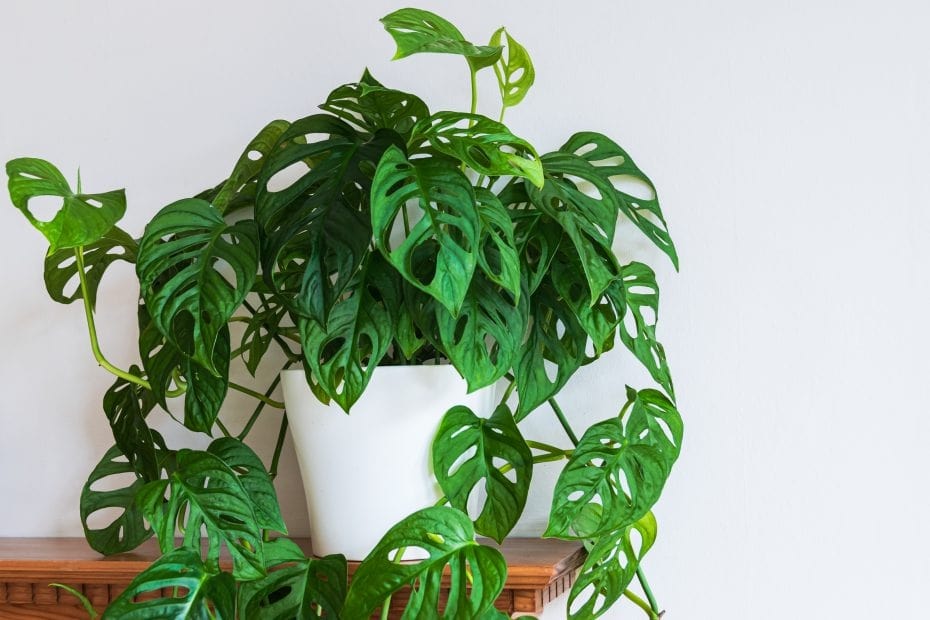
| Ease of Growing | Moderate ●●○○○ |
| Blooming Season | Rarely blooms, known for unique leaf structure |
| Size | Height: Up to 12 feet, Width: 3-5 feet |
| Light | Bright, indirect light, can tolerate lower light conditions |
| Soil | Well-draining potting mix |
| Temperature | 65-75°F (18-24°C) |
| Watering | Keep soil evenly moist, allow the top inch to dry out |
| Toxicity | Toxic to pets if ingested |
| Benefits | Air-purifying, adds a tropical touch to indoor spaces |
Providing some form of support, such as a trellis or moss pole, can help the Monstera adansonii climb and display its characteristic fenestrated leaves. Fertilize the Monstera adansonii every 2-4 weeks during the growing season with a balanced liquid fertilizer.
Avoid over-fertilization as this can lead to salt accumulation in the soil. Keep an eye out for potential pests like spider mites and aphids, especially when grown indoors.
Pothos (Epipremnum aureum)
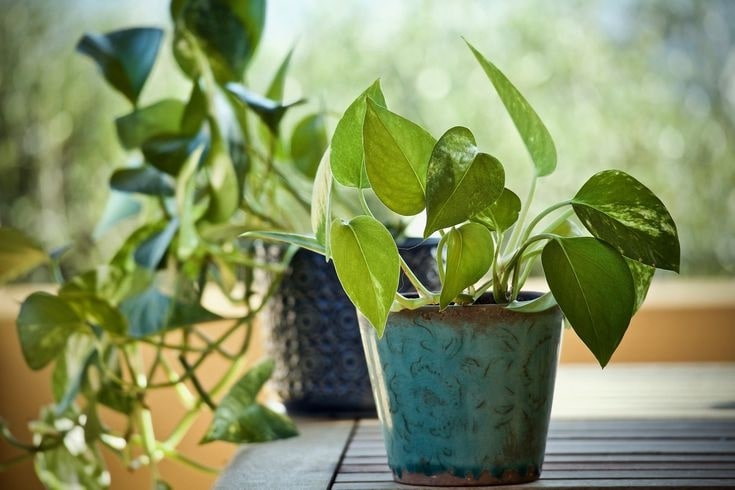
| Ease of Growing | Easy ●○○○○ |
| Blooming Season | Rarely blooms, primarily grown for foliage |
| Size | Height: 6-10 feet, Width: Can spread extensively |
| Light | Low to moderate light, can tolerate low-light conditions |
| Soil | Well-draining potting mix |
| Temperature | 65-75°F (18-24°C) |
| Watering | Allow soil to dry between watering, can tolerate drought |
| Toxicity | Toxic to pets if ingested |
| Benefits | Air-purifying, adaptable to various indoor conditions |
Pothos is a resilient plant and can recover well from pruning – even if it’s a bit excessive. Fertilize the Pothos every 4-6 weeks during the growing season with a balanced liquid fertilizer.
Pothos is relatively resistant to pests, but occasional inspection for spider mites or mealybugs is recommended, especially in indoor settings. It’s important to note the plant’s toxicity, especially if you have pets or small children.
String of Nickels (Dischidia imbricata)
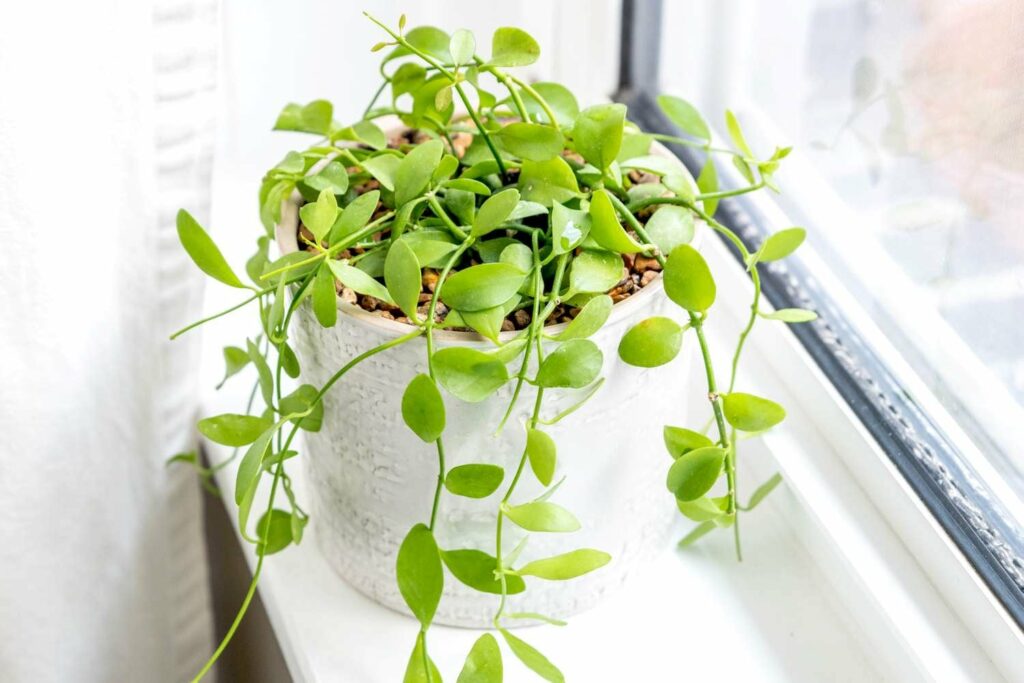
| Ease of Growing | Moderate ●●○○○ |
| Blooming Season | Small, inconspicuous flowers |
| Size | Trailing, up to 12 inches in length |
| Light | Bright, indirect light, can tolerate some direct sunlight |
| Soil | Well-draining, epiphytic mix |
| Temperature | 65-75°F (18-24°C) |
| Watering | Keep soil consistently moist, avoid waterlogged conditions |
| Toxicity | Generally non-toxic, but caution with pets |
| Benefits | Unique trailing form, suitable for hanging baskets |
Trimming back any leggy or overly long stems helps the String of Nickels stay compact and promotes a fuller appearance. Fertilize the plant every 4-6 weeks during the growing season with a diluted, balanced liquid fertilizer.
Keep an eye out for pests such as spider mites or aphids, particularly in indoor settings. Try misting the plant or placing a tray of water nearby to enhance humidity.
English Ivy (Hedera helix)
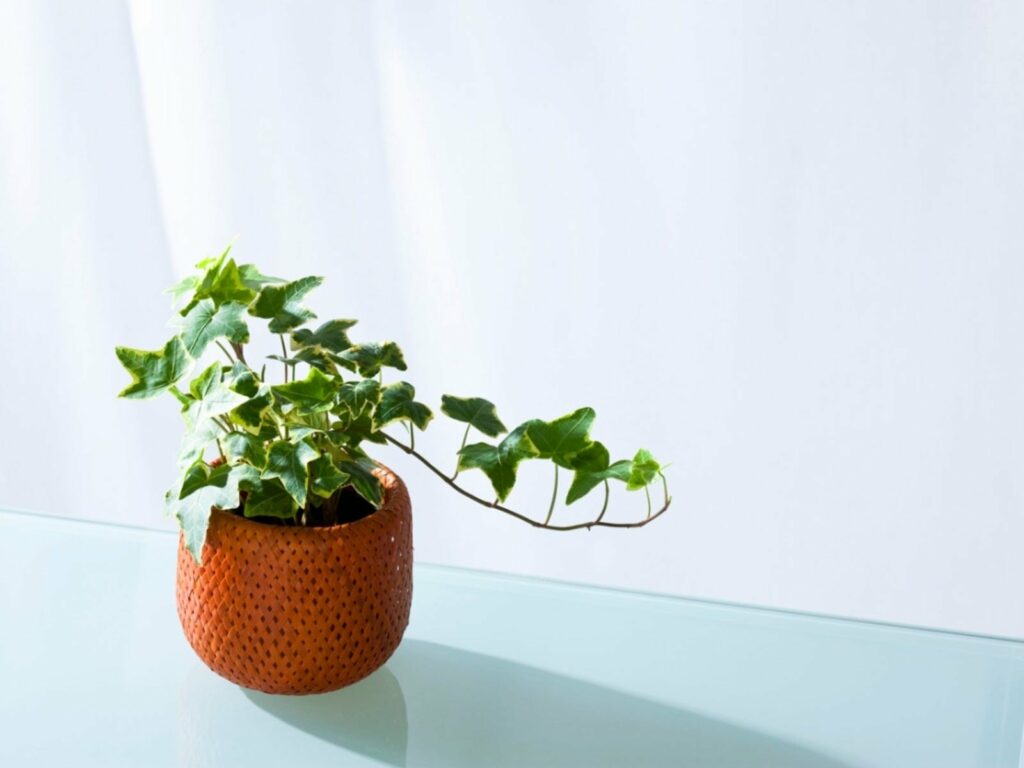
| Ease of Growing | Easy ●○○○○ |
| Blooming Season | Rarely blooms, primarily grown for its foliage |
| Size | Trailing or climbing, can reach up to 80 feet in length |
| Light | Partial to full shade, can tolerate some direct sunlight |
| Soil | Well-draining, slightly acidic to slightly alkaline |
| Temperature | 50-75°F (10-24°C) |
| Watering | Keep soil consistently moist, avoid waterlogged conditions |
| Toxicity | Toxic to pets if ingested |
| Benefits | Air-purifying, versatile in various growing conditions |
English Ivy benefits from regular pruning to control its growth and maintain a neat appearance. Fertilize the English Ivy sparingly, usually in the spring and summer, with a balanced liquid fertilizer.
Keep an eye out for common pests like aphids and spider mites, especially when grown indoors. When growing English Ivy indoors, ensure it receives enough indirect light and maintain consistent humidity levels.
Heartleaf Philodendron (Philodendron hederaceum)
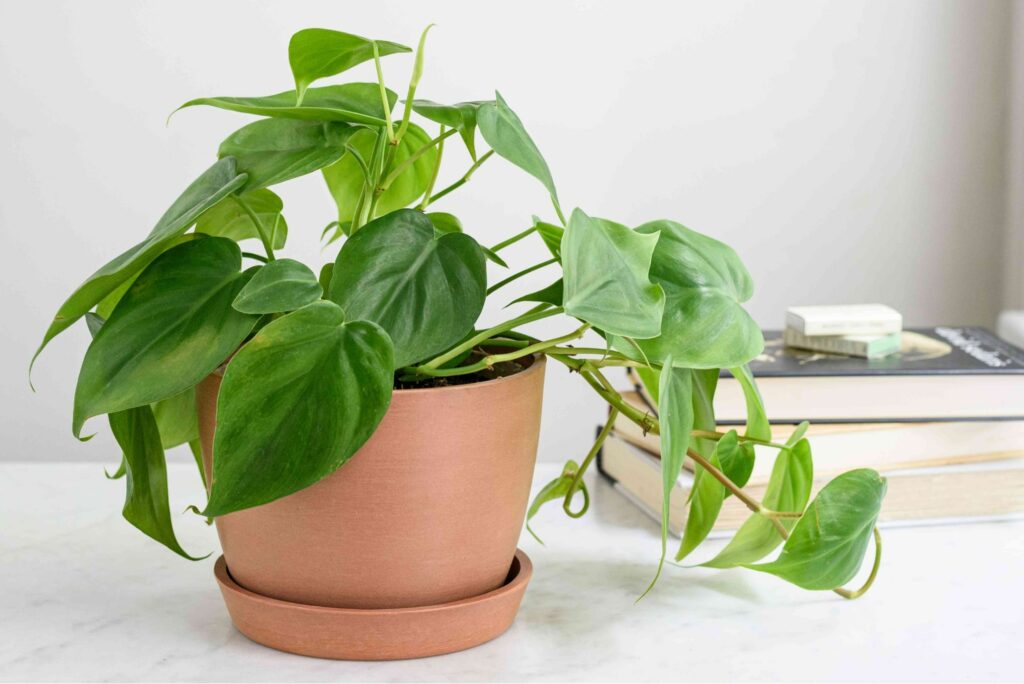
| Ease of Growing | Easy ●○○○○ |
| Blooming Season | Rarely blooms, primarily grown for its heart-shaped leaves |
| Size | Trailing, can reach up to 10 feet in length |
| Light | Low to moderate light, can tolerate some indirect sunlight |
| Soil | Well-draining potting mix, rich in organic matter |
| Temperature | 65-80°F (18-27°C) |
| Watering | Allow soil to dry between watering, prefers slightly moist soil |
| Toxicity | Toxic to pets if ingested |
| Benefits | Air-purifying, adaptable to various indoor conditions |
Trimming back long stems and removing yellow or damaged leaves helps maintain a neat and attractive appearance. Heartleaf Philodendron can be propagated easily by taking cuttings, allowing you to expand your collection or share with others.
Fertilize the Heartleaf Philodendron every 2-4 weeks during the growing season with a balanced liquid fertilizer. Keep an eye out for pests like spider mites or aphids, especially in indoor settings.
Satin Pothos (Scindapsus pictus)
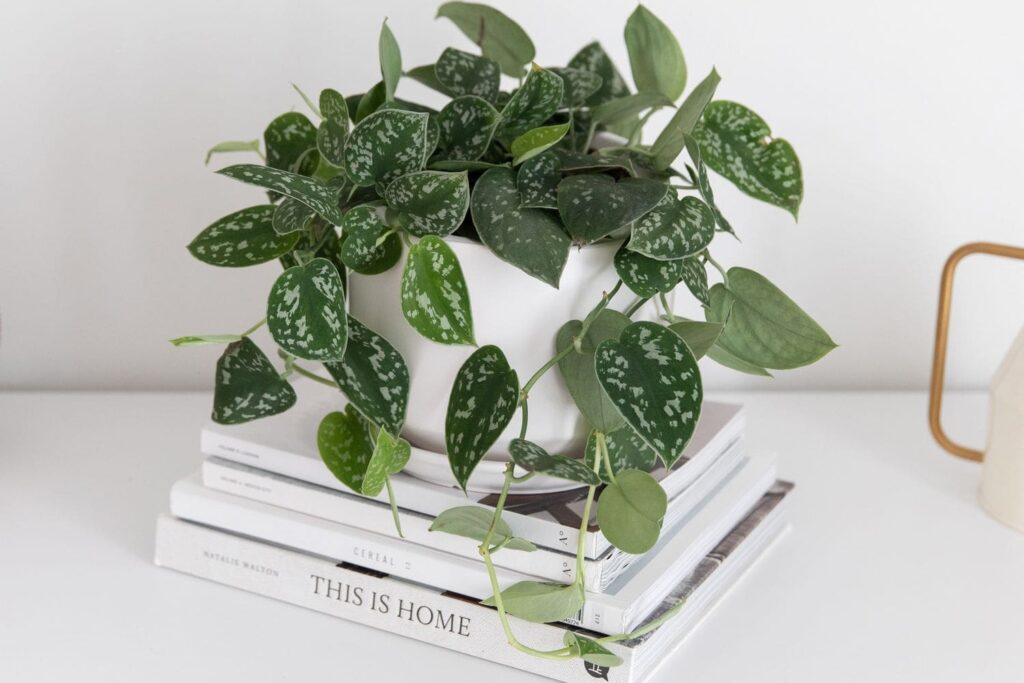
| Ease of Growing | Easy ●○○○○ |
| Blooming Season | Rarely blooms, primarily grown for its foliage |
| Size | Trailing, up to 6 feet in length |
| Light | Low to moderate light, can tolerate some indirect sunlight |
| Soil | Well-draining potting mix |
| Temperature | 60-80°F (16-27°C) |
| Watering | Allow soil to dry between watering, prefers slightly moist soil |
| Toxicity | Mildly toxic to pets if ingested |
| Benefits | Air-purifying, unique silvery-green leaves |
Satin Pothos grows better from regular pruning to maintain its trailing form and encourage new growth. Fertilize the Satin Pothos every 4-6 weeks during the growing season with a balanced liquid fertilizer.
Keep an eye out for pests like spider mites or aphids, especially in indoor settings. Maintain a consistent watering routine for Satin Pothos, allowing the topsoil to dry out slightly between waterings.
Boston Fern (Nephrolepis exaltata)
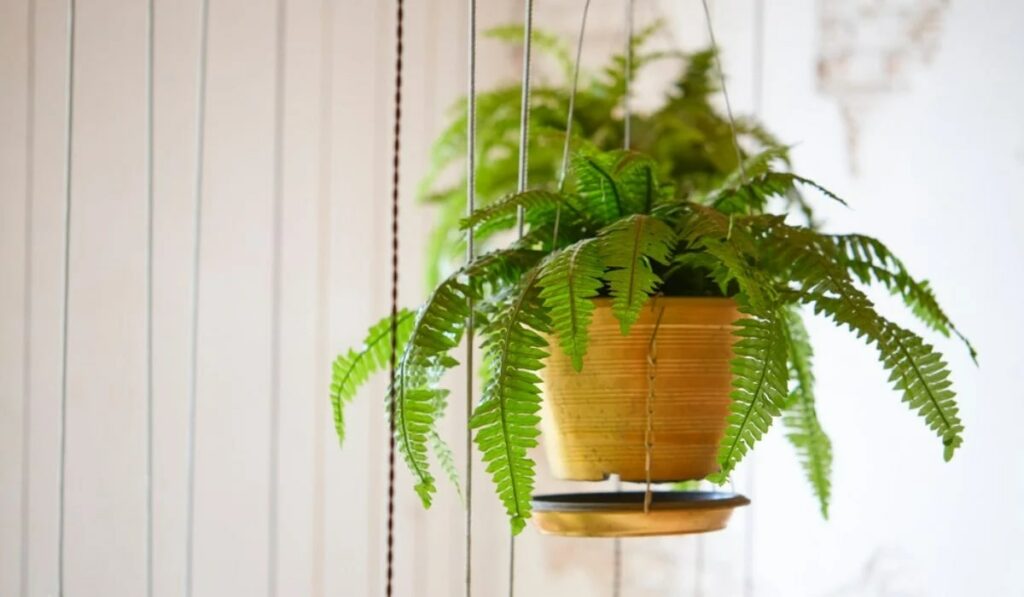
| Ease of Growing | Moderate ●●○○○ |
| Blooming Season | Non-flowering, grown for its feathery fronds |
| Size | Arching fronds, can reach 1-3 feet in height |
| Light | Indirect bright light, can tolerate lower light conditions |
| Soil | Well-draining, high in organic matter |
| Temperature | 60-75°F (16-24°C) |
| Watering | Keep soil consistently moist, high humidity preferred |
| Toxicity | Non-toxic |
| Benefits | Air-purifying, adds a touch of greenery to indoor spaces |
Boston Fern benefits from regular pruning to remove old or yellowing fronds and encourage new growth. Pruning is particularly important during the growing season to keep the fern looking lush and healthy.
Fertilize the Boston Fern with a balanced liquid fertilizer every 4-6 weeks during the growing season – typically spring to early autumn. Reduce or stop fertilization during the winter months when the plant is not actively growing.
String of Hearts (Ceropegia woodii)
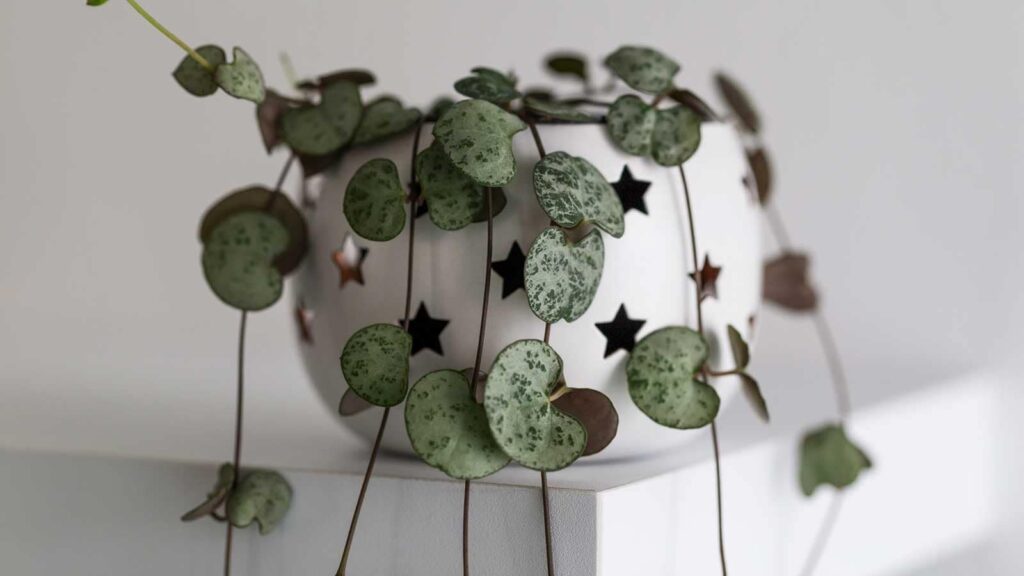
| Ease of Growing | Easy ●○○○○ |
| Blooming Season | Small, tubular flowers, blooms intermittently |
| Size | Trailing, can reach up to 4 feet or more |
| Light | Bright, indirect light, can tolerate some direct sunlight |
| Soil | Well-draining, sandy or succulent mix |
| Temperature | 60-75°F (16-24°C) |
| Watering | Allow soil to dry between watering, drought-tolerant |
| Toxicity | Mildly toxic if ingested |
| Benefits | Unique trailing form, suitable for hanging baskets |
Give the String of Hearts regular pruning to control its length and encourage fuller growth. Fertilize the String of Hearts sparingly, usually in the spring and summer, with a diluted, balanced liquid fertilizer.
String of Hearts is drought-tolerant and prefers slightly drier conditions. Ensure proper drainage in the pot to prevent waterlogging, as overly wet soil can lead to root rot.
Mini Monstera (Rhaphidophora tetrasperma)
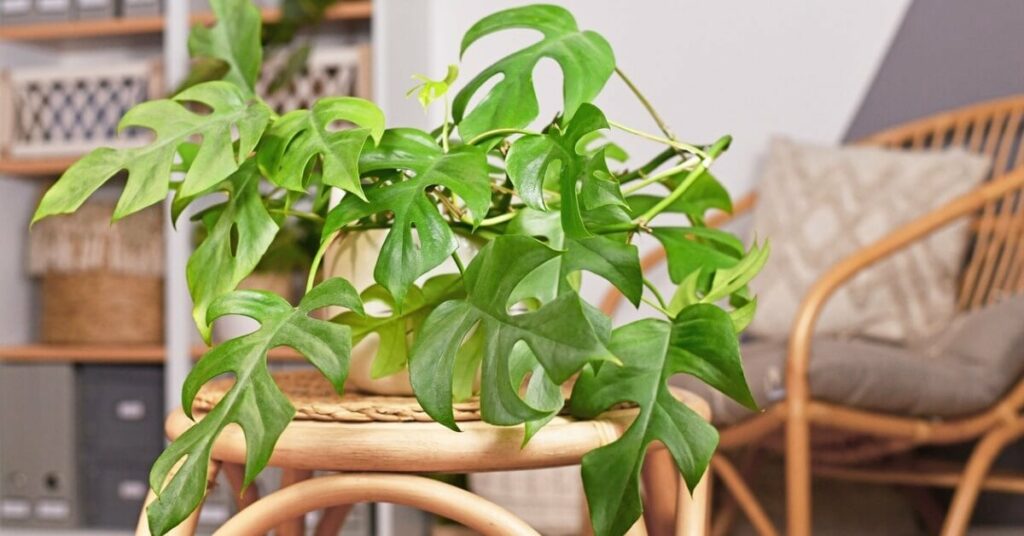
| Ease of Growing | Easy ●○○○○ |
| Blooming Season | Rarely blooms, grown for its split leaves and trailing vines |
| Size | Climbing or trailing, can reach up to 12 feet |
| Light | Bright, indirect light, can tolerate lower light conditions |
| Soil | Well-draining potting mix |
| Temperature | 65-75°F (18-24°C) |
| Watering | Allow soil to dry between watering, moderately drought-tolerant |
| Toxicity | Mildly toxic if ingested |
| Benefits | Unique split leaves, versatile in various indoor settings |
Occasionally prune the Mini Monstera to control its size and shape by trimming back leggy vines to promote bushier growth and maintain an attractive appearance. Propagation is also relatively easy as you can root cuttings to create new plants.
Fertilize the Mini Monstera every 4-6 weeks during the growing season with a balanced liquid fertilizer. Keep an eye out for pests like spider mites or mealybugs, especially in indoor settings.
Neon Robusta Arrowhead Plant (Syngonium ‘neon robusta’)
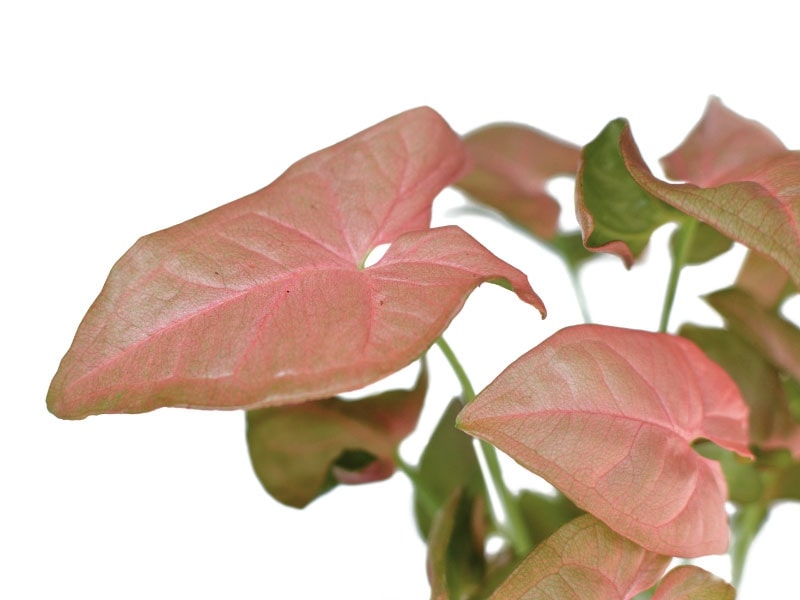
| Ease of Growing | Easy ●○○○○ |
| Blooming Season | Rarely blooms, grown for its vibrant foliage |
| Size | Compact and bushy, up to 3 feet in height |
| Light | Bright, indirect light, can tolerate lower light conditions |
| Soil | Well-draining potting mix, rich in organic matter |
| Temperature | 60-75°F (16-24°C) |
| Watering | Keep soil consistently moist, avoid waterlogged conditions |
| Toxicity | Toxic if ingested |
| Benefits | Vibrant neon-colored leaves, suitable for various settings |
You can give Neon Robusta Arrowhead Plant a regular pruning to maintain its compact and bushy form. Fertilize the Neon Robusta Arrowhead Plant every 4-6 weeks during the growing season with a balanced liquid fertilizer.
Keep an eye out for pests like spider mites or aphids, especially in indoor settings. Neon Robusta Arrowhead Plant appreciates higher humidity levels, so mist the leaves or place a tray of water nearby, especially in drier indoor environments.
Staghorn Fern (Platycerium bifurcatum)
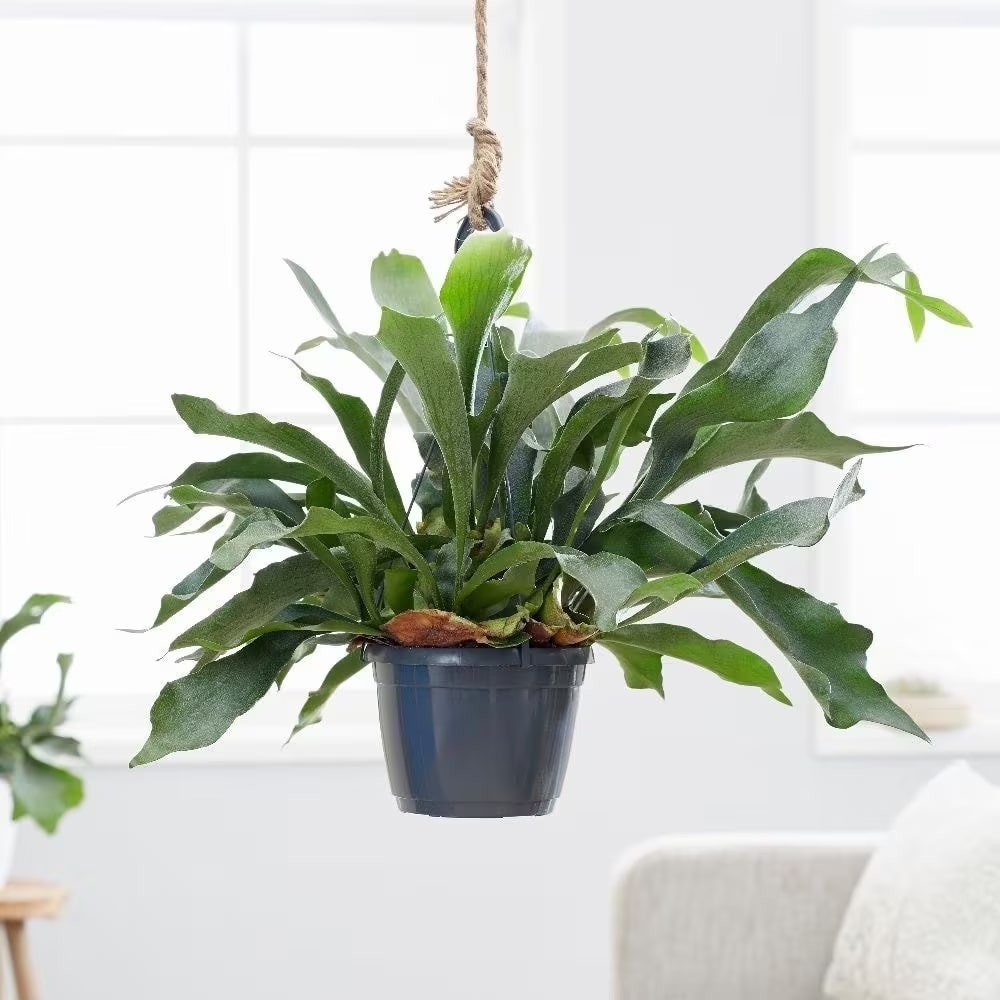
| Ease of Growing | Moderate ●●○○○ |
| Blooming Season | Rarely blooms, notable for its unique fronds |
| Size | Unique antler-like fronds, can span up to 3 feet or more |
| Light | Indirect bright light, filtered sunlight, can tolerate shade |
| Soil | Epiphytic, well-draining potting mix with organic matter |
| Temperature | 60-75°F (16-24°C) |
| Watering | Keep soil consistently moist, water the shield fronds |
| Toxicity | Non-toxic |
| Benefits | Air-purifying, distinctive and artistic appearance |
The antler fronds of the Staghorn Fern are more delicate and should be watered by soaking them in water for about 15-30 minutes. Alternatively, you can water the shield fronds by either misting or watering with a gentle stream.
Fertilize the Staghorn Fern sparingly, around every 4-6 weeks during the spring to early autumn season with a diluted balanced liquid fertilizer. Keep an eye out for pests such as scale insects, mealybugs, or spider mites, especially in indoor settings.
Lipstick Plant (Aeschynanthus japhrolepis)
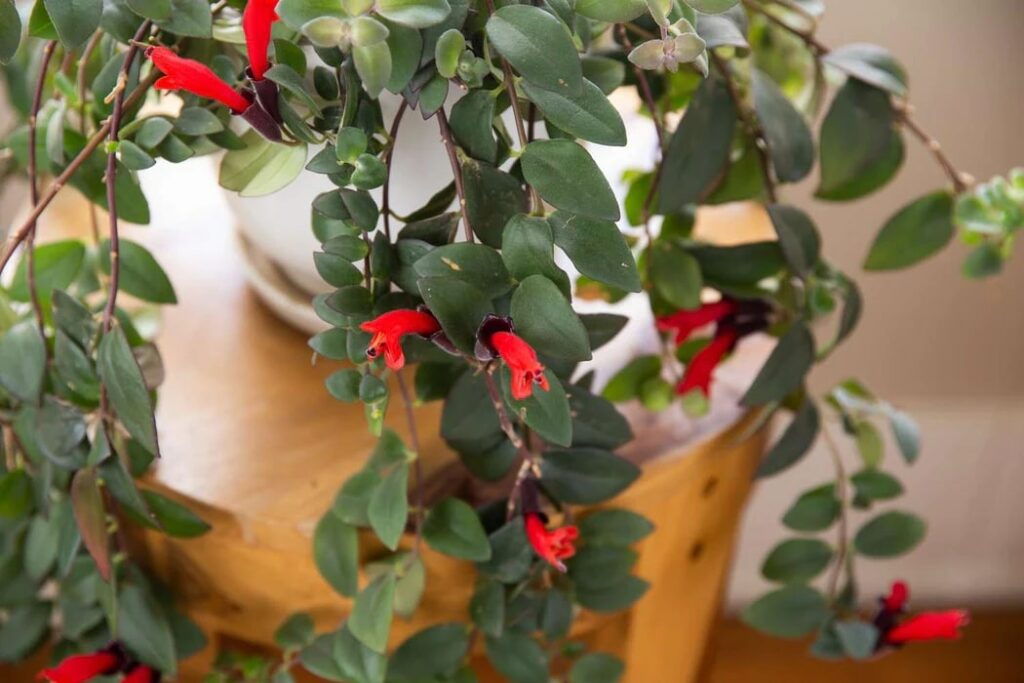
| Ease of Growing | Moderate ●●○○○ |
| Blooming Season | Blooms throughout the year, distinctive tubular flowers |
| Size | Trailing, can reach up to 12 inches or more |
| Light | Bright, indirect light, can tolerate lower light conditions |
| Soil | Well-draining potting mix |
| Temperature | 60-75°F (16-24°C) |
| Watering | Keep soil consistently moist, allow topsoil to dry slightly |
| Toxicity | Non-toxic |
| Benefits | Unique tubular flowers, attractive trailing growth |
Give the Lipstick Plant pruning occasionally to encourage bushier growth and maintain an attractive shape. Trim back leggy stems and pinch off spent blooms to promote continuous flowering.
Fertilize the Lipstick Plant every 4-6 weeks during the growing season with a balanced liquid fertilizer. Keep an eye out for pests like aphids or spider mites, especially in indoor settings.
Golden Pothos (Epipremnum aureum)
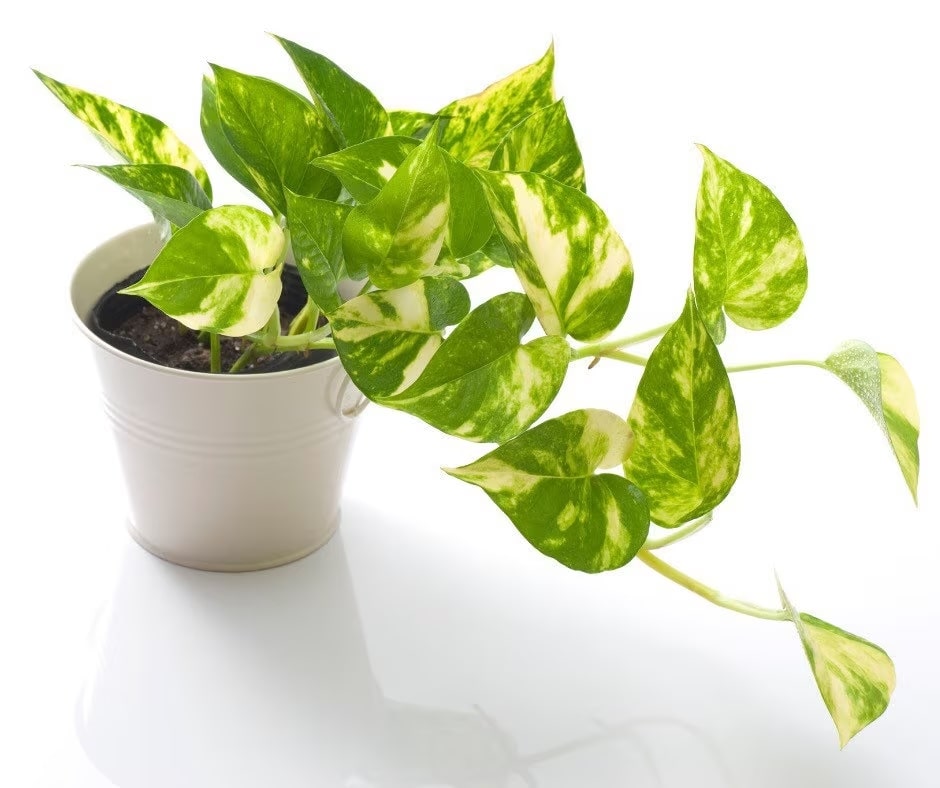
| Ease of Growing | Easy ●○○○○ |
| Blooming Season | Rarely blooms, primarily grown for its foliage |
| Size | Trailing or climbing, can reach up to 10 feet or more |
| Light | Low to moderate light, can tolerate bright indirect light |
| Soil | Well-draining potting mix |
| Temperature | 65-75°F (18-24°C) |
| Watering | Allow soil to dry between watering, drought-tolerant |
| Toxicity | Toxic to pets if ingested |
| Benefits | Air-purifying, adaptable to various indoor conditions |
Golden Pothos is known for its resilience and low-maintenance nature. Trimming back long vines helps maintain a neat appearance, control its size, and encourage bushier growth.
The pruned cuttings can be used for propagation, allowing you to create new plants. Fertilize the Golden Pothos every 4-6 weeks during the growing season with a balanced liquid fertilizer.
Radiator Plant (Peperomia obtusifolia)
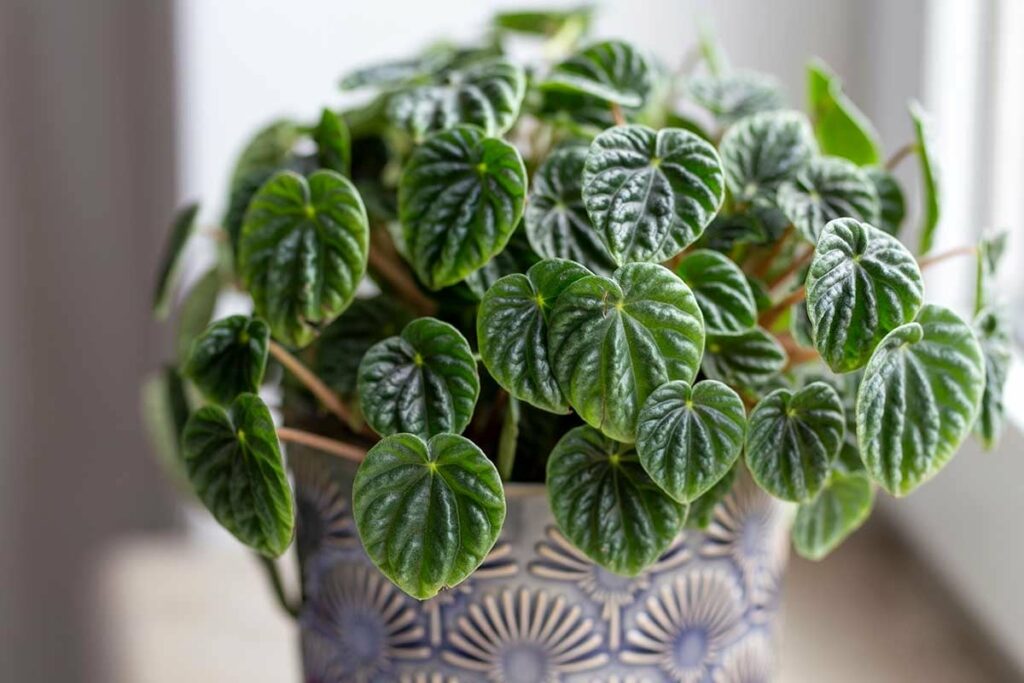
| Ease of Growing | Easy ●○○○○ |
| Blooming Season | Inconspicuous flower spikes, primarily grown for foliage |
| Size | Compact and bushy, up to 8 inches in height |
| Light | Moderate to bright, indirect light, can tolerate lower light conditions |
| Soil | Well-draining potting mix, slightly acidic to neutral |
| Temperature | 65-75°F (18-24°C) |
| Watering | Allow soil to dry between watering, avoid overwatering |
| Toxicity | Non-toxic |
| Benefits | Compact size, attractive foliage with glossy texture |
Keep the Radiator Plant compact by trimming or pinching back the stems to promote new growth and business. Propagation is relatively easy, and new plants can be grown from leaf cuttings or stem cuttings.
Fertilize the Radiator Plant every 4-6 weeks during the growing season with a balanced liquid fertilizer. Keep an eye out for pests like spider mites or mealybugs, especially in indoor settings.
Neon Pothos (Epipremnum aureum ‘Neon’)
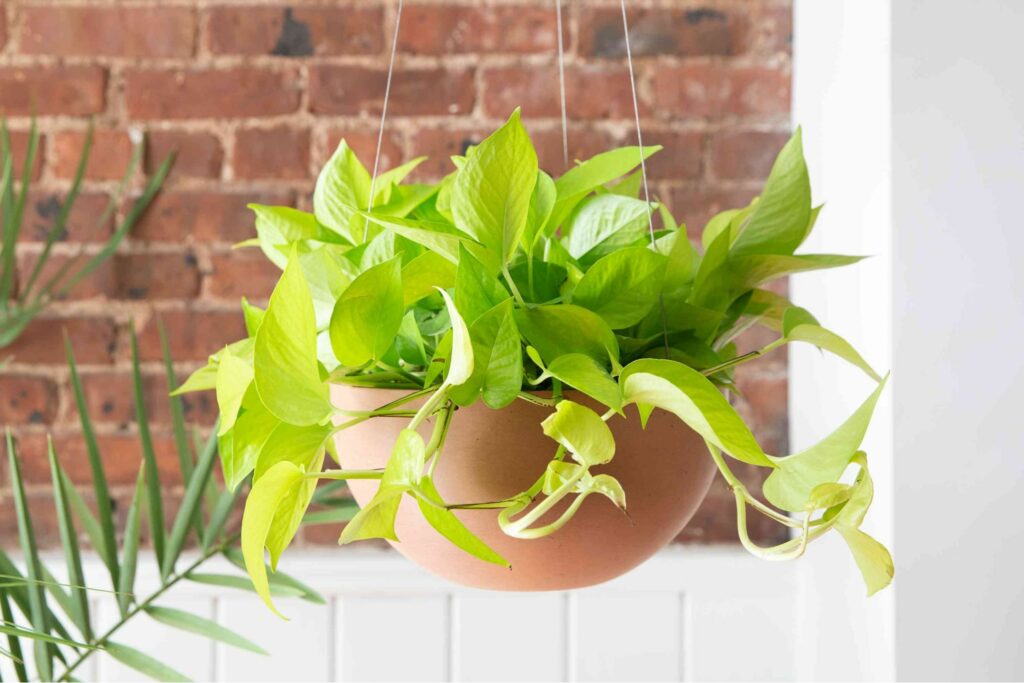
| Ease of Growing | Easy ●○○○○ |
| Blooming Season | Rarely blooms, primarily grown for its vibrant foliage |
| Size | Trailing or climbing, can reach up to 10 feet or more |
| Light | Bright, indirect light, can tolerate lower light conditions |
| Soil | Well-draining potting mix |
| Temperature | 65-75°F (18-24°C) |
| Watering | Allow soil to dry between watering, drought-tolerant |
| Toxicity | Toxic to pets if ingested |
| Benefits | Air-purifying, vibrant neon-colored leaves |
Give the Neon Pothos regular pruning to control its size and encourage bushier growth. Fertilize the Neon Pothos every 4-6 weeks during the growing season with a balanced liquid fertilizer.
Neon Pothos is generally resistant to pests, but occasional inspection for spider mites or mealybugs is advisable, especially in indoor settings. Maintain a consistent watering routine, allowing the topsoil to dry out between waterings.
Hoya Tricolor (Hoya carnosa ‘tricolor’)
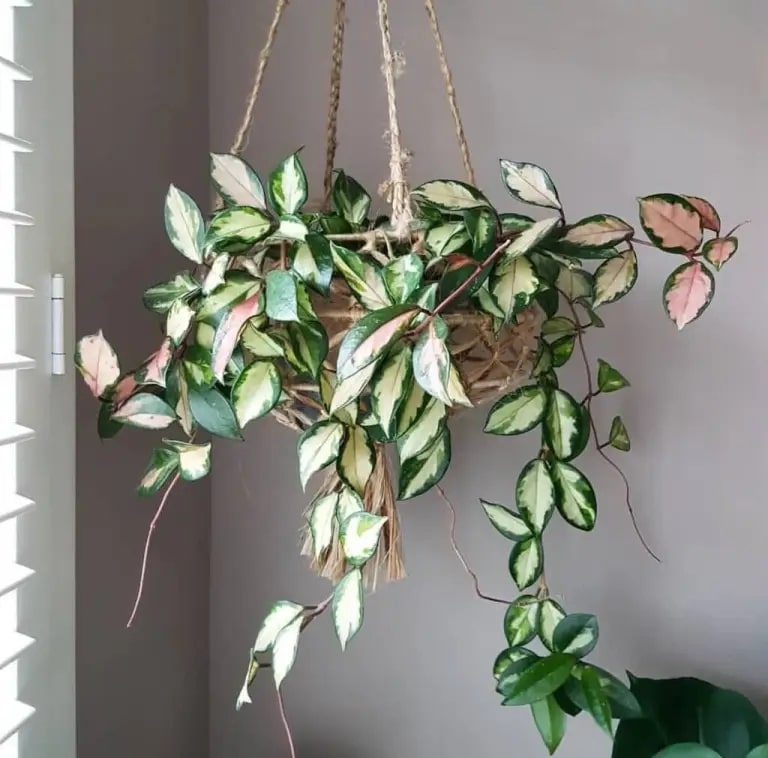
| Ease of Growing | Moderate ●●○○○ |
| Blooming Season | Clusters of fragrant pink and white flowers |
| Size | Trailing or vining, can reach several feet in length |
| Light | Bright, indirect light, can tolerate some direct sunlight |
| Soil | Well-draining potting mix, slightly acidic to neutral |
| Temperature | 60-75°F (16-24°C) |
| Watering | Allow soil to dry between watering, avoid waterlogged conditions |
| Toxicity | Mildly toxic if ingested |
| Benefits | Unique tricolor foliage, fragrant flowers |
Trimming back long stems of the Hoya Tricolor to maintain a compact and bushy appearance. Pruning also encourages the plant to produce more colorful foliage and flowers.
Plus, the cuttings can be used for propagation. Fertilize the Hoya Tricolor sparingly, approximately every 4-6 weeks during the growing season, with a balanced liquid fertilizer.
Bird’s Nest Fern (Asplenium nidus)
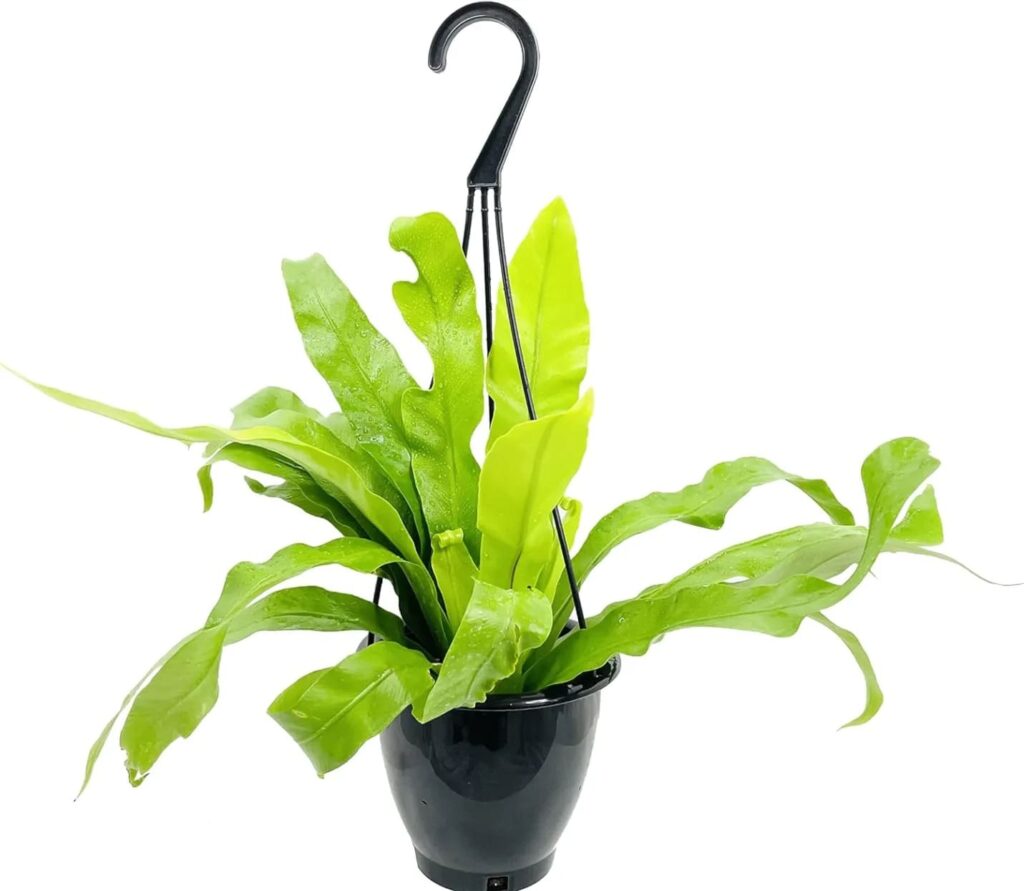
| Ease of Growing | Easy to Moderate ●●○○○ |
| Blooming Season | Rarely blooms, primarily grown for its foliage |
| Size | Rosette shape, can reach up to 2-3 feet in diameter |
| Light | Indirect bright light, can tolerate lower light conditions |
| Soil | Well-draining, rich organic mix |
| Temperature | 70-80°F (21-27°C) |
| Watering | Keep soil consistently moist, high humidity preferred |
| Toxicity | Non-toxic |
| Benefits | Air-purifying, distinctive nest-like fronds |
Trim off any old or yellowing fronds at the base of the Bird’s Nest Fern plant. Wiping the fronds with a damp cloth helps keep them clean and dust-free, promoting better growth.
Fertilize the Bird’s Nest Fern every 4-6 weeks during the growing season with a balanced liquid fertilizer, diluted to half strength. Regularly inspect the plant for pests like scale insects or mealybugs, especially in indoor settings.
Spider Plant (Chlorophytum comosum)
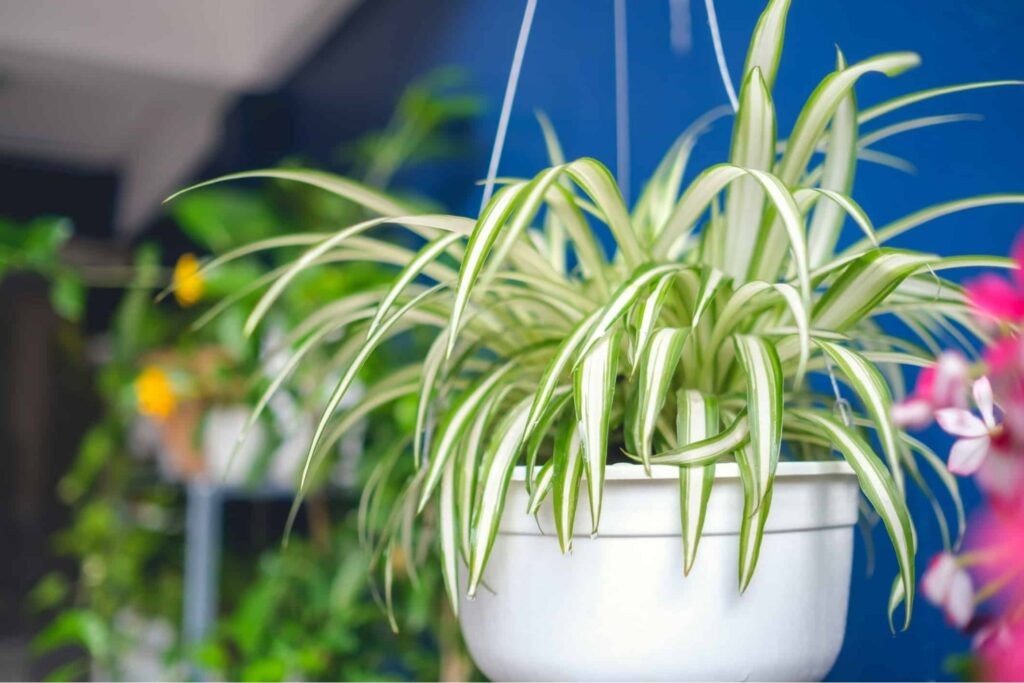
| Ease of Growing | Easy ●○○○○ |
| Blooming Season | Produces small white flowers, typically in spring or early summer |
| Size | Arching, grass-like leaves, can reach up to 2 feet or more |
| Light | Moderate to bright, indirect light, can tolerate lower light conditions |
| Soil | Well-draining potting mix |
| Temperature | 60-75°F (16-24°C) |
| Watering | Allow soil to dry between watering, drought-tolerant |
| Toxicity | Non-toxic |
| Benefits | Air-purifying, produces baby plantlets known as “spiderettes” |
Give Spider Plant regular pruning to remove brown or yellow leaves and encourage new growth. The plantlets, also known as “spiderettes,” can be left on the plant or potted separately to create new plants.
Fertilize the Spider Plant every 2-4 weeks during the growing season with a balanced liquid fertilizer. Spider Plants are generally resistant to pests, but occasional inspection for spider mites or mealybugs is advisable, especially in indoor settings.
Wandering Jew (Tradescantia zebrina)
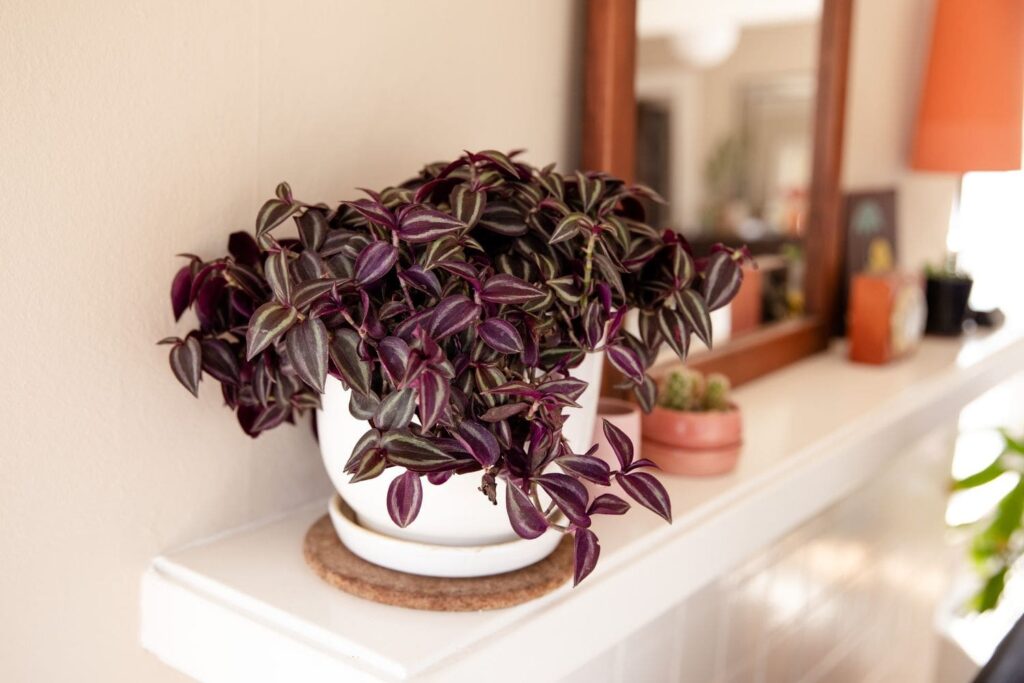
| Ease of Growing | Easy ●○○○○ |
| Blooming Season | Small, three-petaled pink or purple flowers |
| Size | Trailing or hanging, can reach several feet in length |
| Light | Bright, indirect light, can tolerate lower light conditions |
| Soil | Well-draining potting mix |
| Temperature | 65-75°F (18-24°C) |
| Watering | Allow soil to dry between watering, drought-tolerant |
| Toxicity | Mildly toxic if ingested |
| Benefits | Trailing growth, vibrant purple and green striped leaves |
Trimming back the Wandering Jew’s long stems helps maintain a compact and attractive appearance. The pruned cuttings can be used for propagation, allowing you to create new plants or share them with others.
Fertilize the Wandering Jew every 4-6 weeks during the growing season with a balanced liquid fertilizer. Keep an eye out for pests like spider mites or aphids, especially in indoor settings.





